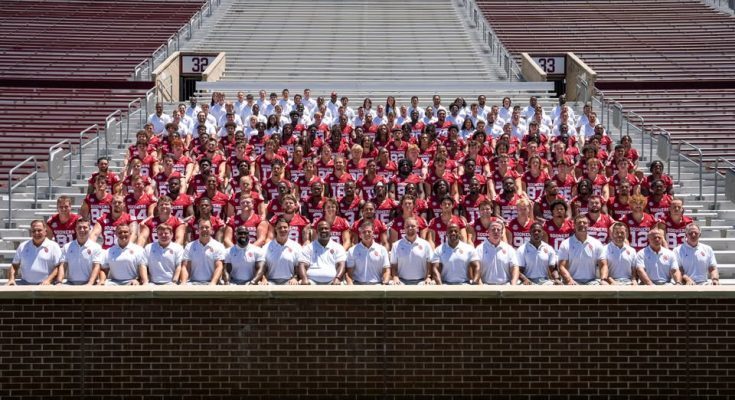As the sun rises on a new college football season, the Michigan Wolverines—fresh off their 2024 national championship—enter the 2025 campaign with a thunderous roar, not a whisper. The echoes of last season’s confetti are still drifting in the air, but inside the hallowed halls of Schembechler Hall and across the maize-and-blue faithful, a new rallying cry is ringing louder than ever: Team 131 is not satisfied with one. They want two. The chase for back-to-back national championships is officially underway, and Michigan has made it clear—they intend to run through anyone in their way.
Team 131 refers to the 131st iteration of Michigan football, a program with a storied past, an imposing present, and a tantalizing future. After decades of falling just short on the national stage, Michigan finally reclaimed its spot atop the mountain in January, defeating the Washington Huskies in the College Football Playoff National Championship. It was a coronation years in the making, fueled by rugged defense, a relentless rushing attack, and a program-wide identity rooted in toughness, discipline, and unity. But what separates this team from so many others who rest on their laurels after reaching the summit is their refusal to celebrate for too long. According to coaches, players, and insiders, the work for title number two began almost immediately after the locker room celebrations ended.
Gone are several key pieces from last year’s title squad, including quarterback J.J. McCarthy, running back Blake Corum, and a host of defensive standouts now plying their trade on Sundays in the NFL. But what remains is a cultural foundation so firm that losing players doesn’t rattle expectations—it reinforces them. Head coach Sherrone Moore, taking the reins full-time following Jim Harbaugh’s departure to the NFL, has injected his own brand of leadership into a program he’s helped nurture for years. Moore’s connection to the players is undeniable, and his football mind is deeply respected. More importantly, his championship experience as offensive coordinator last year has given him credibility and momentum that few first-year head coaches ever enjoy.
Moore has emphasized a simple mantra throughout spring and summer workouts: “This isn’t about defending a title. It’s about chasing another.” That hunger has been palpable in every practice session. No one is coasting. There’s a noticeable edge to this team, an understanding that being the hunted rather than the hunter brings a different kind of pressure—one they are more than ready to embrace.
Leading the offensive charge this season will be quarterback Alex Orji, who brings a dynamic dual-threat capability to the position. While not yet proven on the national stage, Orji’s athleticism and command of the locker room have coaches buzzing. The offense is expected to be more vertical, more explosive, and perhaps even more dangerous in broken play situations. Orji has reportedly made massive strides in understanding defenses, improving his throwing mechanics, and developing chemistry with a young but promising receiving corps led by Tyler Morris and Semaj Morgan. Veteran offensive linemen like Zak Zinter and Giovanni El-Hadi return to give the Wolverines the kind of trench dominance that has become their identity under offensive line coach Grant Newsome.
Defensively, Michigan again expects to be among the nation’s elite. Although they lost major contributors like Junior Colson, Mike Sainristil, and Kris Jenkins, the defensive cupboard is far from bare. Edge rushers Derrick Moore and Josaiah Stewart headline a unit that intends to live in opposing backfields, while linebacker Ernest Hausmann and cornerback Will Johnson—already one of the best in the country—are primed to lead. Defensive coordinator Jesse Minter has returned with a vengeance after flirting with NFL opportunities in the offseason, and he’s brought with him a few schematic wrinkles designed to confuse quarterbacks and generate turnovers at a higher rate than even last season.
Yet what may ultimately separate Team 131 from the rest of the contenders is not just talent or coaching—it’s cohesion. There’s a brotherhood here, a shared vision that transcends individual accolades. Several players reportedly turned down lucrative NIL opportunities to return for one more run. That kind of commitment doesn’t go unnoticed. It sets a tone. It creates a standard. And it feeds the kind of culture where younger players buy in instantly because the seniors are walking examples of everything the program preaches.
National analysts are split on Michigan’s chances to repeat. Some see the loss of star power and Harbaugh’s departure as too much to overcome. Others see a loaded roster, a soft non-conference schedule, and a Big Ten slate that gives Michigan ample time to gel before the high-stakes November matchups. One thing no one disputes, however, is the target now painted squarely on Michigan’s back. Every opponent on the schedule will circle the Wolverines in red. Every stadium they visit will have a little extra juice. But rather than shrink from that pressure, Team 131 seems to be thriving in it.
Their goals are clear. Beat rivals Michigan State and Ohio State. Win the Big Ten. Return to the College Football Playoff. Finish the job again.
Players like defensive lineman Kenneth Grant, offensive tackle LaDarius Henderson, and safety Rod Moore have echoed the same sentiment in media sessions: Last year was special. But we haven’t even played our best football yet.
That belief, whether proven true or not, has resonated throughout the college football world. It’s why Michigan currently ranks inside the preseason top three in nearly every major poll. It’s why Vegas oddsmakers list them as a betting favorite to return to the national title game. And it’s why, perhaps most importantly, opposing programs have already started studying their tendencies more rigorously, seeking any edge they can find against the reigning champs.
Inside Ann Arbor, the anticipation has reached a fever pitch. Season ticket sales have shattered previous records. Merchandise is flying off the shelves. “Team 131” hoodies, hats, and banners are now fixtures around campus and throughout the state. The maize-and-blue faithful believe this could be another legendary ride—and they intend to enjoy every second of it.
Former Wolverines are also rallying around the current squad. Charles Woodson, Tom Brady, Desmond Howard, and others have publicly supported Moore and his team. There’s a sense that Michigan football isn’t just experiencing a moment—it’s entering a new era. An era where annual championship contention isn’t just hoped for; it’s expected.
That expectation brings with it enormous pressure. But it also brings opportunity. The opportunity to go from great to historic. To etch their names alongside the few programs in modern college football history to win consecutive national championships. To leave behind a legacy that won’t just be remembered in Ann Arbor, but across the nation for generations to come.



